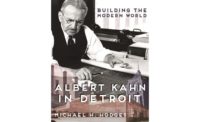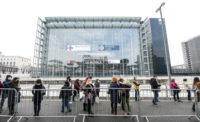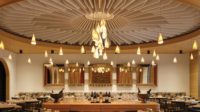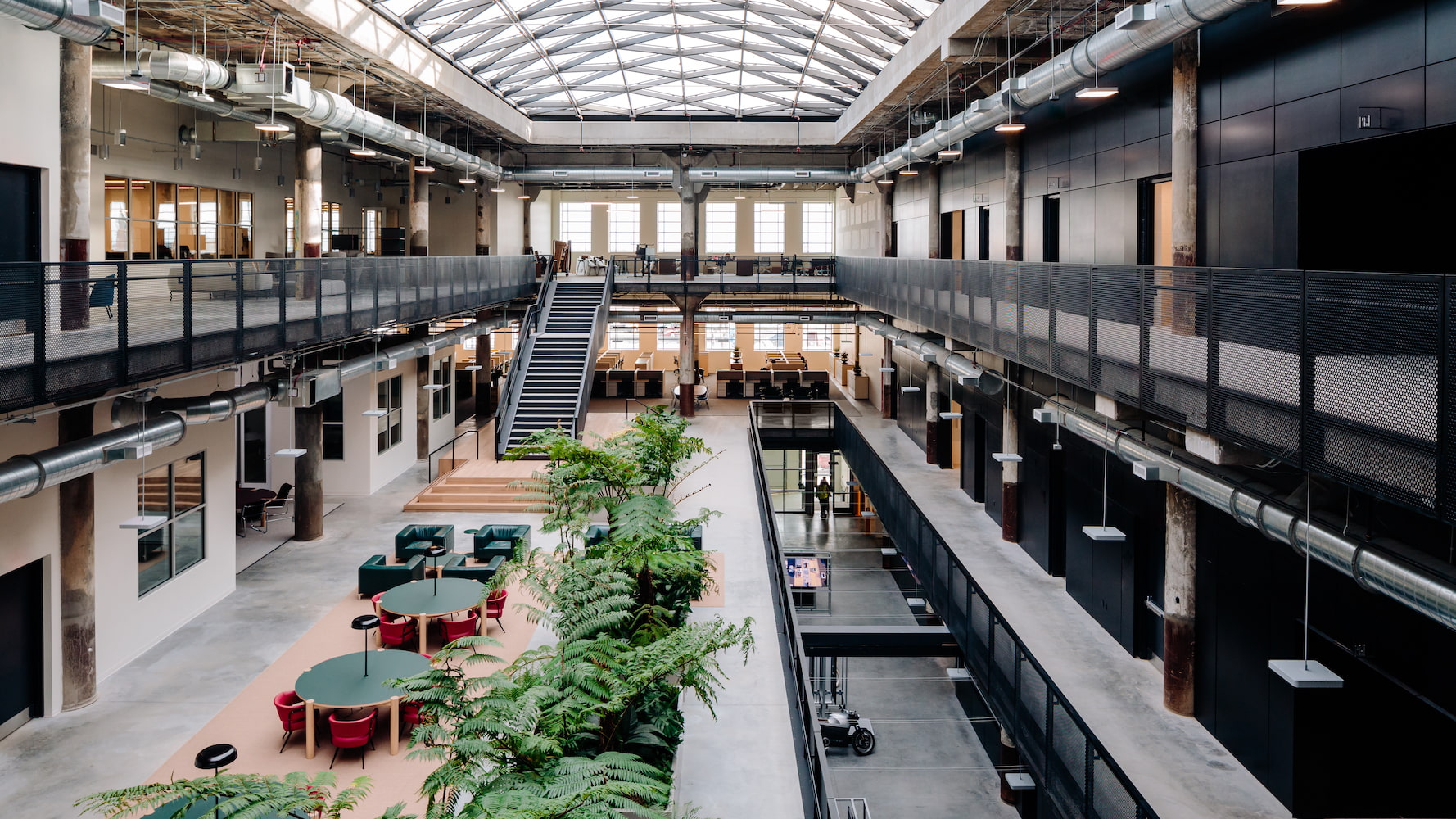Albert Kahn’s Long-Abandoned Detroit Book Depository Transformed Into Newlab’s Latest Innovation Hub

A 1936 post office-turned-public school book depository has been transformed into Newlab’s Detroit headquarters. Photo by Brian W. Ferry
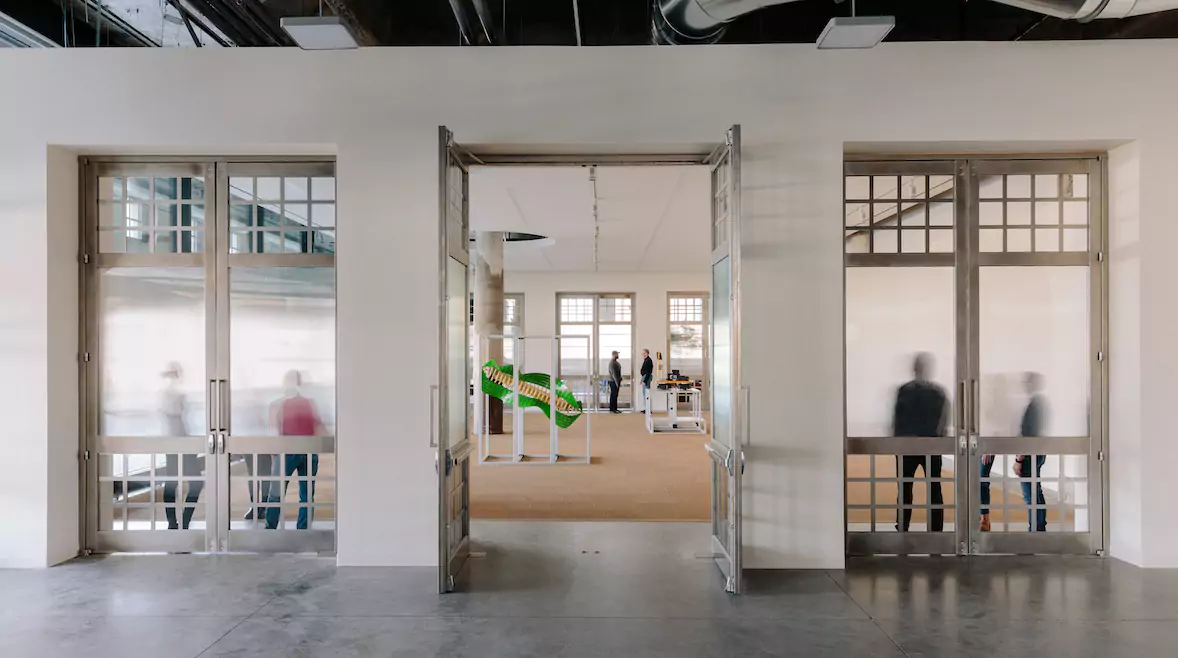
The view from a café through the entry lobby. Photo by Brian W. Ferry
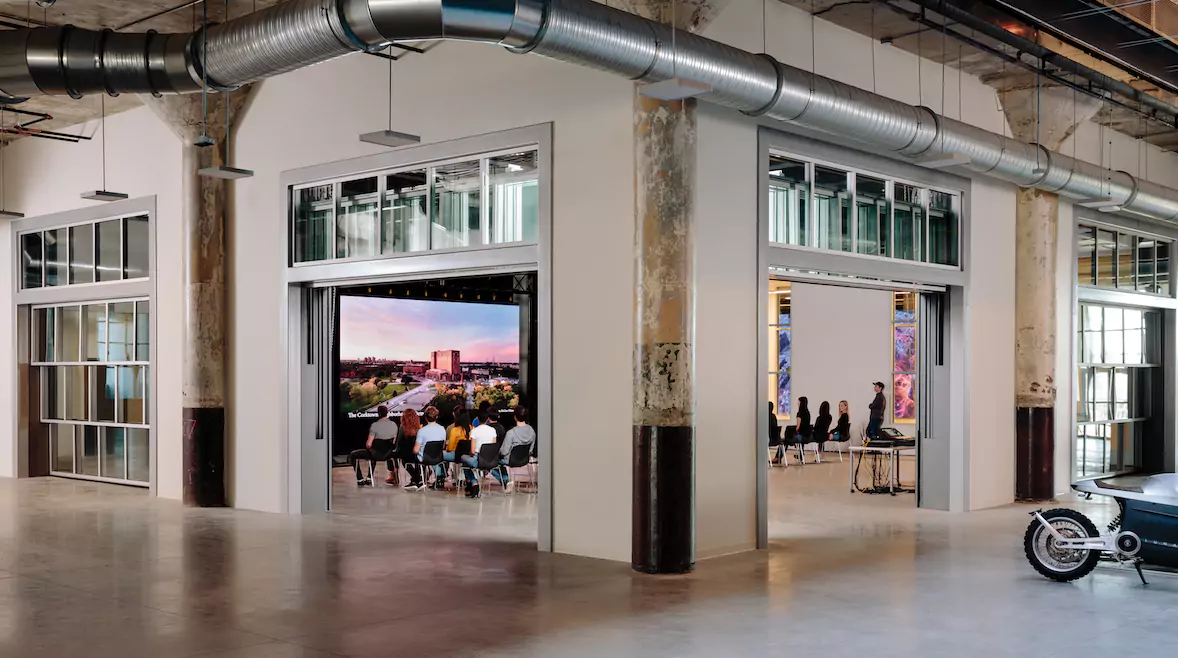
Civilian created an event space and gallery on the ground floor. Framed by Kahn’s martini glass columns, the space has custom roll-up doors for views and access to the work being done in the surrounding shops. Photo by Brian W. Ferry



Architects & Firms
On April 25, hundreds of people gathered for the opening of Newlab’s Motor City headquarters located at the historic Detroit Public Schools Book Depository, a 270,000-square-foot former post office-turned-school supplies warehouse designed by Albert Kahn in 1936. Newlab—an interdisciplinary technology center for start-ups that launched at the Brooklyn Navy Yard in 2016—hopes its Detroit hub, stunningly rehabilitated by Gensler and the New York–based architecture and interior design studio Civilian after decades of neglect, will be a “center of gravity” for entrepreneurs, engineers, and scientists working to develop new technologies across mobility, sustainable energy, and materials.

The Roosevelt Warehouse, or Book Depository as the building is best known, is an Art Deco landmark. A March 1987 fire left the structure a burned-out shell, and it sat empty for the next 35 years. Photo by Brian W. Ferry
One hundred and fifty people from more than 25 companies, many of them Detroit-based, have already set up shop in the newly revived three-story structure in the city’s Corktown neighborhood; more will come when the monumental project is complete later this year. Newlab’s carefully curated member companies are creating drone management platforms, advanced roadways, autonomous wheels, electric vehicle charging stations, and air pollution monitoring solutions, among other new technologies, and will be able to take their ideas from napkin sketches to complete prototypes in the facility’s robotics and digital fabrication labs, wood and metal shops, and private studio spaces.
Newlab Detroit is the first completed piece of a 30-acre mobility innovation campus developed by Michigan Central, a Ford Motor Company brand. The automaker’s executive chairman Bill Ford purchased Kahn’s decaying Book Depository in 2018 along with the adjacent Michigan Central Station, once one of the grandest railway hubs in the United States. Idle since Amtrak’s exit in 1988, it has long been an icon of Detroit’s painful decline.

1

2
Newlab, a technology hub for start-ups, contains woodshops, 3D printing labs, metal shops, and more—everything an inventor could need to take an idea from “napkin sketch” to prototype (1). Daylit lounge areas are one of the many amenities for Newlab members (2). Photos by Brian W. Ferry
But Ford and Michigan Central have big ambitions: The walkable Corktown campus is meant to provide a link to the sprawling city, a jobs and skills pipeline for young Detroiters, and a testing ground for the products invented within the it, such as smart roads and autonomous vehicles. A decade after the city filed for bankruptcy, the project’s champions are riding a wave of optimism that has been buoyed by a construction and development boom. That’s not to say that the city isn’t still grappling with racial disparity, gentrification, and profound inequality. For their parts, Newlab and the larger Michigan Central campus are aiming to pair technical innovation with economic and social mobility—a theme repeated by Michigan Central leaders and Black business and community leaders who spoke at the opening’s breakout sessions.
Ultimately, Ford has plans for the mixed-use district to employ 5,000 people and include three other new and revitalized buildings that will house restaurants, retail, office space, and art programs, surrounded by public green space. Master-planned by the New York–based Practice for Architecture and Urbanism (PAU), the district is also poised to be a stop along an autonomous vehicle corridor planned for part of Michigan Avenue, the artery linking Corktown to downtown Detroit and Ann Arbor to the west.
The Book Depository is the first jewel in the crown. Gensler began core-and-shell renovations in 2021, keeping the industrial bones of its detailed brick facade, patinated concrete interior, and grid of martini cap columns intact. The project team, led by Lily Diego, design director with Gensler Detroit, was guided by the tenet, “Let there be light.” As architect of record, Gensler decentralized the core to create an internal boulevard and a double atrium, slicing openings through the center of the second and third floors and adding a pillowtop skylight that floods the building with daylight. The firm also removed a loading dock at the northwest corner of the building to create a glazed, carved-out entrance that faces Michigan Central and anticipates the connectivity of the two buildings when the renovation of the station into offices, restaurants, and public spaces is complete.

A five-axis robotic arm. Photo by Brian W. Ferry
Gensler’s renovation was already underway when Newlab signed on as Michigan Central’s partner for the building. Newlab co-founder David Belt engaged Civilian, led by husband-and-wife Nicko Elliott and Ksenia Kanger, as interior architecture consultants and designers. (Ghafari Associates served as interior architect of record.) Civilian had previously designed Newlab’s Brooklyn headquarters within a former 1902 shipbuilding facility. “There was always going to be another Newlab and we had been offered buildings all over the world,” said Belt. “But the mission of Michigan Central, and the fact that it was in Detroit and part of this overarching urban contribution—that’s what brought us here. In Detroit, there’s such intention, spirit, and civic hope.”

Civilian designed a series of bespoke tables and storage cabinets especially for the project, injecting playful color. Photo by Brian W. Ferry
On a tour of the building, Civilian’s Elliott noted that he loved a 1926 photograph of Kahn taken by Walter Gropius, who visited the Jewish Prussian-born architect’s Detroit factories. Kahn, whose rabbi father brought him to Detroit in 1880 when he was 11, denounced modernist architecture, but had a profound influence on those who embraced it, such as Gropius and Le Corbusier. Civilian’s goal for the project was to highlights the building’s history while positing how Newlab’s members could, like Kahn, share and celebrate their modern-day breakthroughs.
To achieve that, Elliott and his team inserted and attached prefabricated “objects” into the historic space, including a café with views on the train station and, at the heart of the project, an exhibition and event space with custom roll-up doors and views into the glass-walled robotics studio. Guests are greeted at Newlab’s entry by a prefabricated rosewood and pressed stainless steel reception desk installed around a martini-glass column.

Gensler flooded the interior with daylight by adding a glazed roof and cutting through floorplates. Civilian’s tree-fern park along the second floor draws visitors upstairs. Photo by Brian W. Ferry
To create a park-like atmosphere within the building, Elliott went to Florida in search of the perfect tree ferns for an interior garden that lines the second-floor atrium and beckons visitors upstairs. Furniture for the lounge areas and workstations include customized Herman Miller tables and cabinets made of ash and laminate. Antique chairs from Dutch workshop and upholstery studio Morentz were reupholstered in vibrant hues. In its selections, Civilian nodded to Kahn’s influence on the Bauhaus and to designers such as Charlotte Perriand.
Kahn was a prolific architect who was more interested in doing the work than extolling it. He developed one quarter of all commercial architectural commissions in Detroit, many of which still stand today, and thousands of industrial campuses abroad. With his engineer brothers, he developed groundbreaking structural feats for automotive factories, but he remained skeptical of mechanization and was equally dedicated to designing towering temples to the Arts & Crafts movement, such as his 1928 Fisher Building in Detroit’s New Center, filled with frescoes, mosaics, bronze plaques, and 56 varieties of marble. (Albert Kahn Associates remains an active practice, with an office and archives in the building.)

3

4
A prefabricated rosewood and pressed stainless steel reception desk greets guests (3). Civilian’s custom furniture draws from 1930's furniture designers who were fascinated with Fordist mass production, machined finishes, laminates, and natural materials (4). Photos by Brian W. Ferry
Belt said of Newlab’s new Detroit home: “We not only wanted to create an amazing working environment, but also make sure that the companies we’re accepting are doing something good for society, the world, and Detroit, and bring those products to market.”
Kahn might have said the same about much of his own portfolio.


